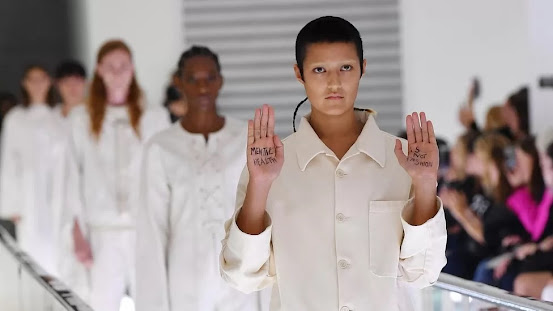Camisole (pronounced kam-uh-sohl)
(1) A short garment worn underneath a sheer bodice to conceal the underwear; also called cami (pronounced kam-ee).
(2) A woman's dressing jacket or short negligée.
(3) A sleeved jacket or jersey once worn by men (now obsolete but occasionally revived as a catwalk novelty).
(4) As camisole de force, a straitjacket with long sleeves (mostly historic references).
1816: From the French and the Old Occitan (also called
Old Provençal) camisola, the
construct being camis(a) + -ola; the Late Latin camīsa
(shirt) was also the source of chemise
and the Latin suffix -ola was added to
a noun to form a (sometimes pejorative) diminutive of that noun; a variant was
the Late Latin camisia (shirt or nightgown).
The thread was well-known in romance languages, the Old Portuguese camisa (shirt) was from the Late Latin camisia (shirt), from Transalpine
Gaulish (of Germanic origin) from the Proto-Germanic hamiþiją (clothes, shirt, skirt), from the primitive Indo-European ḱam- (cover, clothes). The modern use meaning a “sleeveless
undergarment for women” dates from circa 1900 but for most of the late nineteen
the century it generally meant "straitjacket” (a restraint for lunatics). Camisole is a noun & verb and camisoled is a verb & adjective; the noun plural is camisoles.
Camisole de force: The straitjacket
Although
ad-hoc wearable physical restraints had existed long before, the camisole de force (straitjacket) was
invented circa 1772 by Irish doctor David MacBride (1726-1778), the more
romantic story of it being a creation of a Monsieur Guilleret, a tapestry maker
at Bicêtre Hospital, apparently a myth.
The basic concept endures to this day although they are now less used,
having largely been supplanted by camisoles
chimiques (or neuroleptics (a
class of psychotropic drugs used to treat psychosis)). The only fundamental change in design is that
modern camisoles de force are made
with sleeves, the early types restraining the arms directly under the fabric
were found to be most uncomfortable.
Camisole de force on the catwalk: Straitjacket chic by Gucci and others.
Catwalks were once a place where fashion existed for fashion's sake and while there could be social or political implications in what was worn, the messaging usually had to be some sort of overt threat to the establishment for much of a protest to be raised. However, we live now in more sensitive times and designers have to be aware of factors as diverse as religion, ethnicity, skin color, sexual orientation, age, body mass index (BMI) and the seemingly all-encompassing "cultural appropriation". Gucci recently had to withdraw from sale a jumper (US$890, Stg£715) after critics found it too reminiscent of blackface minstrels, the connection being the built-in half-balaclava with knitted plump red lips. That fixed, the fashion house was then accused of cultural appropriation because one of their headpieces (US$790, Stg£635) too closely resembled a Sikh turban. To clarify the extent of the sin, the US-based Sikh Coalition issued a statement: "The Sikh turban is not just a fashion accessory, but it's also a sacred religious article of faith."
Madness (an now unfashionable word banned in polite company; the American Psychiatric Association's (APA) Diagnostic and Statistical Manual of Mental Disorders (DSM) recommending "mental disorder" or "psychiatric disorder") may also be on fashion's banned list after Ayesha Tan-Jones (b 1993, who is non-binary and uses they/them pronouns) staged a non-oral, verbal protest while on the catwalk (they might prefer the less exploitative "runway") in the Gucci show at Milan Fashion Week 2019. Tan-Jones and other models were dressed in white jumpsuits for the show (and it can't be long before even the use of white is declared "problematic"), some of which used the motif of the straitjacket. On their hands, Tan-Jones had written the words "Mental health is not fashion", clearly not accepting Gucci's rationale the designs were meant to represent "how through fashion, power is exercised over life, to eliminate self-expression". That has some linguistic tradition because women have in the past not infrequently described demands to be fashionable as "a straitjacket" but Tan-Jones presumably would prefer the notion remain a simile rather than a publicity stunt.
Ayesha Tan-Jones on the catwalk, Milan Fashion Week, September 2019.
After the show, Tan-Jones issued their own statement, writing "Straitjackets are a symbol of a cruel time in medicine when mental illness was not understood, and people's rights and liberties were taken away from them, while they were abused and tortured in the institution. It is in bad taste for Gucci to use the imagery of straitjackets and outfits alluding to mental patients, while being rolled out on a conveyor belt as if a piece of factory meat." That was followed up with another post which added they, along with some of the other models in the show, were donating to mental health charities a portion (% not mentioned) of the modeling fees paid by Gucci. "Many of the other Gucci models who were in the show felt just as strongly as I did about this depiction of straitjackets, and without their support I would not have had the courage to walk out and peacefully protest" they said. In response, the fashion house didn't address the substantive issued raised but did confirm straitjacket chic was just "...a statement for the fashion show and will not be sold", adding the line was intended as "...an antidote to the colourful designs in the rest of the Spring/Summer 2020 show".
Lindsay Lohan in camisole.




No comments:
Post a Comment